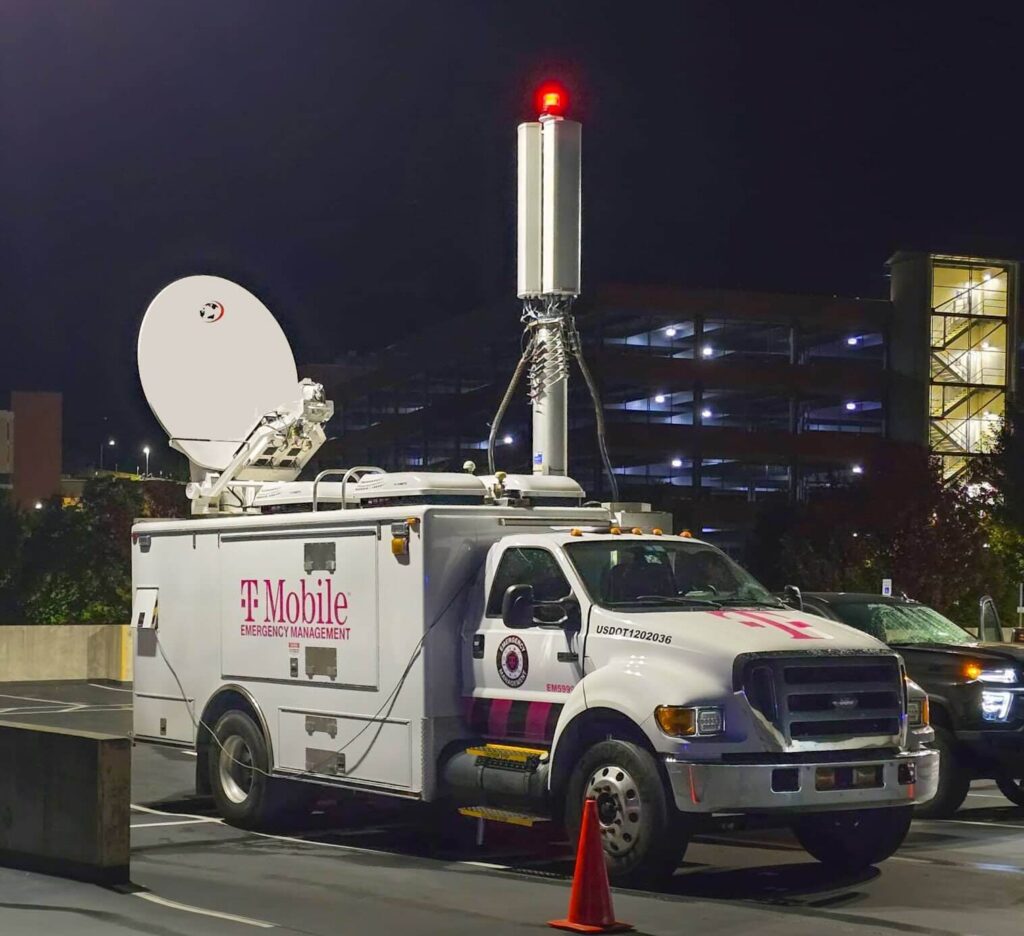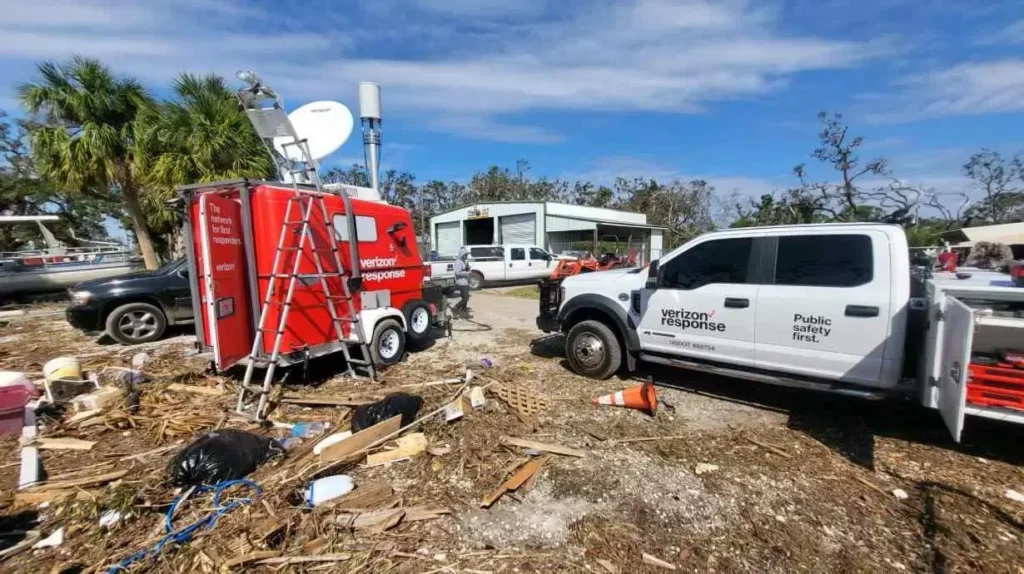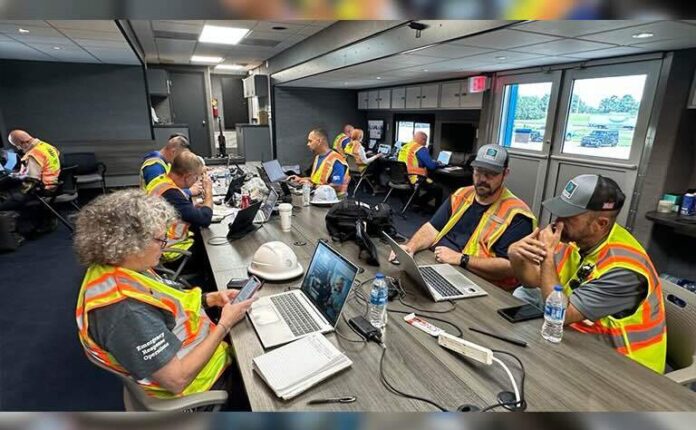Network operators are racing to restore connectivity across five Southeastern states devastated by Hurricane Helene.
Cellular networks across the Appalachian Mountains were taken out by the storm, which blew ashore in Florida as a Category 4 hurricane and then barreled northward, dumping feet of rain, producing tornadoes and high winds that caused damage and power outages across the Southeast and Mid-Atlantic, all the way into Ohio and Indiana. The death toll stands at 120 and rising, with hundreds still missing.
With power, water and cellular sites out in multiple places, The New York Times has reported people huddling close to a closed library in Asheville, N.C. to use the Wi-Fi signal to send texts and attempt make contact with family and friends, and debating whether to use their dwindling gas supplies to drive there in order to get connectivity.
While Hurricane Helene hit Florida’s Big Bend area and did damage along the coast as expected, the most severe network and human impacts have been hundreds of miles inland, due to massive flooding from Helene in the Appalachians, particularly in the mountains of the Carolinas. In fact, as of today the FCC narrowed the required network status reporting to just one county in Florida, while maintaining active reporting status for dozens of counties in Georgia, Virginia and the Carolinas.
According to tracking site poweroutage.us, as of 10 a.m. ET on Tuesday, more than 1.5 million customers across five states were still without power, with the most outages persisting in South Carolina (more than 600,000) and Georgia (more than 460,000).
All three of the national carriers are waiving fees for customers in the impacted areas, as well as providing charging and Wi-Fi access. In terms of cellular network response, here are the recent carrier updates:
AT&T said on Monday that it has fielded more than 140 requests for FirstNet deployable assets, calling the Helene response “one of the largest mobilizations of our disaster recovery assets for emergency connectivity support.” It has a self-sustaining base camp set up in Georgia, where its Network Disaster Recovery team is staged (see image above).
In terms of the cellular network, “More than 60% of affected cell sites in the impact region have been restored and we will continue to work around the clock,” AT&T said in the Monday update.
The company also noted in a previous that as it repairs its wireless and wired network, it may not have full visibility into whether individual locations have in-home service. “Although equipment that serves an area can be powered and online, we may not be aware of specific in-home service impacts until customers return to their homes and commercial power is restored. Additionally, commercial power outages can continue to affect service for our customers even after our repairs are made,” the carrier warned in a Sunday update.
AT&T added in that same update that while network improvements were already evident in Florida, “our crews have reported North Carolina and South Carolina have significant damage and those repairs will take a considerable amount of time.”
T-Mobile US reported on Sunday that its network was “completely or nearly restored in Virginia, Kentucky, Indiana, Ohio and Pennsylvania and most of Florida including Tampa, Miami and Orlando.” As of yesterday, more than half its off-air sites in West Virginia were back up. Additional deployables were being put in the field in Georgia, but the most severe challenges were in the Carolinas. On Sunday, the carrier said that its crews had “overcome extremely challenging conditions and limited site access to restore 132 sites and position 149 portable generators”, and were continuing their work.

The carrier has added more community support locations where it is providing free charging and Wi-Fi, including multiple sites in Asheville.
In Tennessee, T-Mo said that one damaged fiber location was repaired in Johnson City, but additional fiber cuts had been identified. “Once those are repaired majority of service should be restored in the area,” it said.
Verizon said Monday that it has put more than 70 deployables in the field to provide temporary coverage, including a cellular-enabled tethered drone called a HAWK (High Altitude Wireless Kennewhat). “Significant progress has been made in Florida, with only a small number of sites still being addressed,” the carrier said, adding that it is also seeing progress in upstate South Carolina and in Georgia.
“However, a substantial amount of work remains in the hardest hit areas. With recent access to South Appalachia, we have been deploying a large number of assets and temporary backhaul units to restore service. We are also working closely with our fiber providers in this area to restore service as quickly as possible and will not stop until all service in the area is restored,” Verizon said. The carrier said in a previous update that the unprecedented flooding was accompanied by “widespread fiber damage.”

The FCC said that across the affected areas, the percentage of cell sites that were out dropped from 9.1% on Sunday to 6.7% on Monday. However, that varied widely across geographies, with many areas having more than half of their sites down. In some counties in the Carolinas, as many as 90% or more of the sites remain down due to either damage, loss of power or loss of backhaul connectivity.
As a visual record of progress on restoration, you can compare the FCC outage maps from Sunday, Sept. 29 and Monday, Sept. 30 below:

Above: Federal Communications Commission reported percentages of cell sites down, Sunday Sept. 29. Image: FCC

Above: Federal Communications Commission reported percentages of cell sites down, Monday, Sept. 30. Image: FCC
The global tech industry could also see indirect impacts from Hurricane Helene, beyond the task of network recovery. As reported by NPR, the small town of Spruce Pine in North Carolina is the sole U.S. source of high-purity quartz for semiconductors and solar panels. Helene inundated Spruce Pine with more than two feet of water, cutting off power, water and cellular service and washing out roads. Quartz producer The Quartz Corp. issued a statement today saying that it is focused on its employees and trying to get service restored amid a “dramatic situation for our region.”
The company added: “Our focus is to ensure that our employees and their families are safe while all efforts are made to contact those which are still unreachable. In addition to this, our teams are joining the local taskforces to try to restore the most basic services and bring further supplies to Spruce Pine,” the company said. “Operations at our facilities were stopped on September 26th in preparation of the event and we have no visibility on when they will restart. This is second order of priority. Our top priority remains the health and safety of our employees and their families.”

